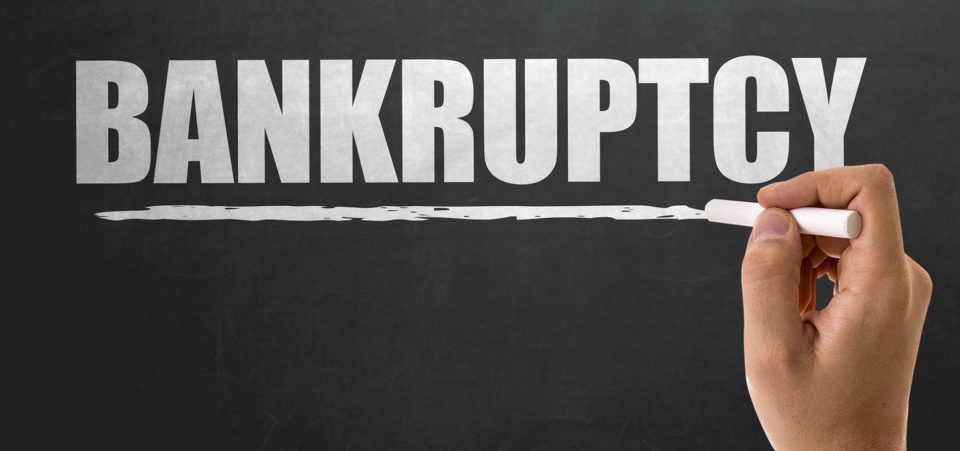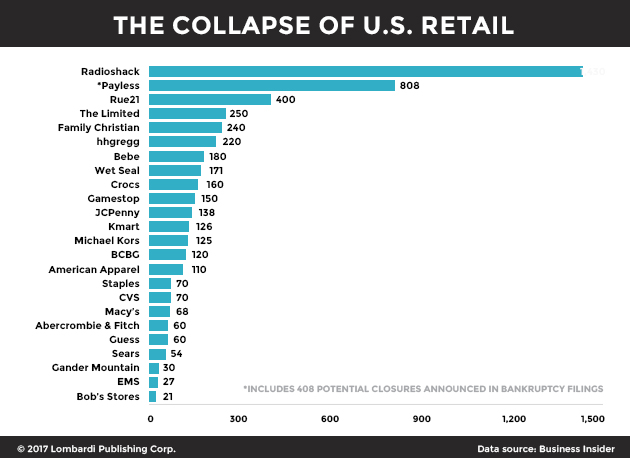Retailers at Risk of Bankruptcy a Sign of Coming Economic Collapse 2017
Several economists, including Nouriel Roubini, the expert who predicted the outbreak of the 2008 financial crisis, are seeing red. They fear the economic policies put forward by the Trump administration. They also fear the current political and economic context, noting that the system is producing excessive uncertainty. Therefore, the risk of a U.S. economic collapse in 2017 is high and getting higher by the week.
While many economists and finance analysts continue to see only blue skies, the signs of a coming U.S. economic collapse are everywhere. U.S. retailers are filing for bankruptcy, or they are shutting down their stores at a dizzying pace. During this past spring, some 2,000 store closures were announced. But, there will be more retail stores closing in 2017. The total number could reach upwards of 8,600 by the end of the year. (Source: “Stores are closing at an epic pace,” CNN Money, April 22, 2017.)
The trend can only get worse from there. Store closures have accelerated, even or especially in large cities. You don’t need much more evidence for that than Sears Holdings Corp (NASDAQ:SHLD). Once one of the pillars of the entire retail sector, Sears risks bankruptcy in the United States, while Sears Canada has already announced it.
But how much longer can other major retailers survive? Such other longstanding retail chains as Macy’s Inc (NYSE:M), Nordstrom, Inc. (NYSE:JWN) and J C Penney Company Inc (NYSE:JCP) have been shutting stores down. The Canadian retail chain, Hudson’s Bay Co (TSE:HBC), which owns Saks Fifth Avenue among other retail brands, announced job cuts and store closures in June. Most of these will occur in the United States, contributing to an all-around economic crash in 2017.
Amazon Wants to Get into the Food Business as Traditional Retailers Fall
In a related example, Amazon.com, Inc. (NASDAQ:AMZN) announced that it is buying Whole Foods Market, Inc. (NASDAQ:WFM), the premium food retailer, for just under $14.0 billion. The acquisition will allow the master of online shopping to sell its products in brick-and-mortar stores or adapt Whole Foods’ products for online distribution. (Source: “Amazon to Acquire Whole Foods for $13.7 Billion,” Bloomberg, June 16, 2017.)
The closures, particularly of such premiums and visible brands as Saks or Nordstrom could be fatal for hundreds of shopping malls across the United States. Certainly, investors and consumers can blame the advent and success of online shopping for retailers shutting down their brick-and-mortar stores. But, that’s only a part of the story, and not even the most important part.
Behind the retail closures is the specter of a looming economic crisis. This means that while the demise might be longer, online retailers are not immune from the shopping malaise that has afflicted consumers in the United States. The chances of a financial crisis in 2017 grow as investors continue to inflate the bubble. In turn, this increases the chance of a major stock market crash in 2017.
In the mid-1990s, politicians, starting from President Bill Clinton himself, pundits, and journalists such as Richard Brooks were telling us the economy was performing brilliantly. The internet and the new dot-com startups were going to produce an amazing and prosperous America for everyone. The biggest evidence for this was the soaring stock market. Everyone started to get involved in stocks and optimism abounded. But was it warranted?
A financial crisis in 2017, given the global uncertainties—starting unusually in Washington itself—will not be a minor one-day or one-week affair. The risks are such that the next financial crisis could trigger an economic crisis. There’s no avoiding this spiral of economic doom. Retail stores and their popularity are one of the barometers of the real economy, the one that occurs beyond often meaningless statistics.
As Professor John Clapp of the University of Connecticut said, the retail cycle has become a spiral of doom. Once an important store brand disappears from a mall—say a Saks or a Nordstrom—the influx of customers decreases and impacts other stores.
Retail Is the First Domino of the Economy to Fall
Even such services as manicure salons and small jewelry stores all rely on getting important crumbs from the traffic that visits the big retailers. When these big retailers disappear, they tend to drag smaller businesses with them. (Source: “‘THIS IS A DEATH SPIRAL’: The tsunami of store closures is doubling in size,” Business Insider, June 3, 2017.)
As the shopping malls disappear, the people who live around them will likely follow suit. They will abandon those areas and drive real estate prices down. Meanwhile, as jobs disappear, revenues and earnings drop. This domino effect reaches all the way to the government, because the end result is that tax revenues drop. One needs only to look at what happened in Detroit, for example, to grasp the full sense of the socioeconomic degradation that occurs when key industries enter a terminal phase.
Changes in the auto industry not only wiped out thousands of jobs within Ford Motor Company (NYSE:F), General Motors Company (NYSE:GM) or Fiat Chrysler Automobiles NV (NYSE:FCAU) starting in the 1980s. They also wiped out all the jobs that emerged around the communities of auto industry workers. Eventually, such shifts change the very essence of many American cities, fueling job cuts.
The other side of the spiral is that even the retailers that are performing well may decide to close stores down. Indeed, retailers that fail to close enough stores risk failure, because of the upheaval that is taking place in the retail industry right now. (Source: CNN Money, op cit.)
Surely, this negative prognosis for the U.S. economic outlook might shock many. Indeed, Wall Street appears to have embarked on an unstoppable bullish course. That this “Trump rally,” which began shortly after Trump’s election, is seen as a negative is all the more surprising as the American stock market has its second-best performance since John F. Kennedy became president. Wall Street also tells us that the unemployment rate, at 4.4%, is at its lowest level in more than 10 years. (Source: “Trump rally is 2nd best since JFK,” CNN Money, April 28, 2017.)
The Current Economy Is Like a Skyscraper Without Foundations
But the market performance and these statistics seem to be detached from reality. The retail closures, meanwhile, paint a much different picture. This picture is more realistic and reflects the experiences of real people. That means that the odd euphoria that has taken hold of Wall Street since the election of Donald Trump is like a skyscraper without foundations.
One of the weaknesses is Trump’s political future. The president himself has been forced to admit that special prosecutor Robert Mueller has subpoenaed him on suspicion of obstruction of justice. Without Trump, or with a severely weakened Trump, there are no more Trump economics. Even the Republicans, who have backed Trump so far, will jump ship. The deeper the so-called “Russiagate” investigation (or “witch hunt,” depending on your point of view) goes, the less support Trump will have.
The Trump rally hinges on Trump’s promises of substantial tax cuts, heavy infrastructure investment, and slashing economic regulation. All this, Trump assured Americans, would help push annual GDP to generate some three percent in growth. This optimism has weak legs.
American investors and voters have been overly optimistic. They have underestimated the potential pitfalls of Trump’s policies on one hand. They have also overestimated the Trump administration’s ability to challenge the entrenched interests within the State.
Thus, the problem starts at the very beginning. Trump was a Washington outsider. He has come to the White House, expecting to play a game he knew well. Instead, he’s found that the playing fields have multiple levels and there are more entrenched interests.
Trump has spoken, but not yet gotten through Congress, about adopting more protectionist policies, including the renegotiation of NAFTA, are likely to trigger a trade war between the United States and the rest of the world. Such a scenario would have a very negative impact on international economic relations. Meanwhile, he won’t be able to get any of his economic policies through.
Trump’s Growing Weakness Generates Uncertainty
The will of the new U.S. administration to close borders to immigration will have an immediate and significant impact on the U.S. economy by making it more difficult to attract skilled talent from overseas. At the same time, many U.S. companies have learned to rely on cheap labor—especially in food and agriculture.
The Trump administration announced a $1.0-trillion investment program to repair roads, upgrade airports, and improve bridges. If this infrastructure program is essential to make the U.S. economy more efficient, it will add to the national debt. At the same time, the massive income tax cut, especially for corporations, will make it harder to find the funds to run the infrastructure program.
The proposed tax regime could significantly increase the U.S. deficit by reducing tax overall revenues by some $5.5 trillion from $7.0 trillion over the next decade. Independent estimates suggest that this proposed tax reform alone would raise U.S. federal debt to 111% of GDP by 2027. (Source: “Trump Tax Cuts To Add As Much As $7 Trillion In Debt,” Zero Hedge, April 27, 2017.)
Thus, the increase in debt could seriously damage American economic growth. A couple more lackluster statistics, a prolonged Trump impeachment process—or even its mere shadow—and an unexpected negative stock performance could bring down the entire U.S. economy and grind the public markets to a halt. For too long Wall Street and Main Street haven’t spoken the same language. A market crash will resolve that, but it will be a heavy fall.
Even if Trump survives his enemies’ impeachment attempts, his economic policies risk running the United States into a catastrophic scenario. The stock market crash in 2017 risk has already happened. Add to that the risk of rising unemployment—which the collapse of retail is only accelerating—and such ogres as hyperinflation or even the collapse of the U.S. dollar raise their heads.







